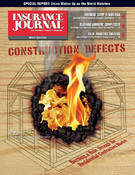California Insurance Commissioner John Garamendi released a statutorily mandated report on the State Compensation Insurance Fund’s (SCIF’s) potential to reduce workers’ comp rates based on his review of its financial condition, underwriting practices and rate structure. The report, prepared by the California Department of Insurance (CDI), found that SCIF could realize additional rate reductions of 5.9 percent for all policyholders by implementing recommendations made by IBM Business Consulting Services (IBM), redirecting its investment portfolio and reducing maximum commission rates. Any potential rate decreases would be in addition to the 9.7 percent in reductions SCIF filed during 2004. “Our exam of SCIF, to the extent it was possible, shows much room for operational improvement as we balance the twin goals of lowering rates and preserving the fund’s solvency,” Garamendi said. CDI determined that SCIF’s underwriting practices, in at least two significant areas, hinder its ability to ensure that each eligible employer is paying the lowest premium possible or that there is not disparate treatment of policyholders in terms of the premiums and deposits paid. Additional findings from CDI’s review include: SCIF’s current underwriting procedures do not allow the Company to maximize employer participation in the Kaiser Alliance and Preferred Provider Network (PPN) programs and safety group programs. State Fund’s failure to communicate the availability of these programs to all policyholders and its failure to collect information to determine who is eligible for participation result in the application of rates that are unfairly discriminatory, according to CDI. SCIF has not adhered to the implementation timeline IBM identified for realizing savings from the recommended reforms and, therefore, will not realize the $294 million of annual savings IBM estimated by 2005. This potential savings translates to a potential rate reduction of approximately 4 percent. SCIF has adopted different procedures for handling direct written accounts with less than $25,000 in annual premiums. This has resulted in small accounts not receiving the same level of disclosure regarding the future costs of their workers’ comp coverage and having these future charges calculated on the basis of less accurate information than is used for all other, larger accounts. In reviewing SCIF’s rate structure, CDI found that SCIF should, among other things, adhere to its filed rating plan by providing credit to directly written accounts.
Topics Pricing Trends
Was this article valuable?
Here are more articles you may enjoy.


 Nearly Half of 100 Largest P/C Insurers Destroy Value: ACORD
Nearly Half of 100 Largest P/C Insurers Destroy Value: ACORD  10 Highest Class-Action Settlements in 2025 Eclipsed $70B Total: Duane Morris
10 Highest Class-Action Settlements in 2025 Eclipsed $70B Total: Duane Morris  Consumer Acceptance of Telematics Widens, Says Survey
Consumer Acceptance of Telematics Widens, Says Survey  Experian: AI Agents Could Overtake Human Error as Major Cause of Data Breaches
Experian: AI Agents Could Overtake Human Error as Major Cause of Data Breaches 


